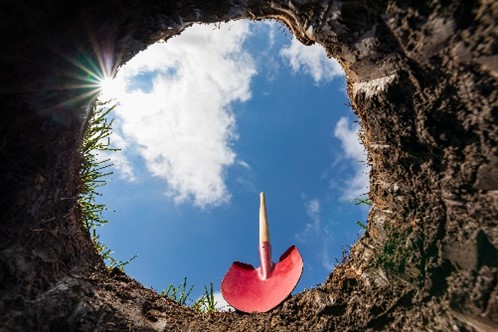BURYING ALLELUIA

A Lenten Spiritual Practice
Lent is a season of preparation. For 40 days and 40 nights, Christians prepare for the events of Holy Week—Jesus’ suffering, betrayal, torture, crucifixion, and death—and for Easter’s empty tomb. Originally, in the earliest years of the Christian church, this 40-day season was for the preparation of those who were to be baptized on Easter, but pretty quickly it became a season of preparation for all church members, a season of penitence, prayer, fasting, service and spiritual reflection, discipline and renewal.
The liturgical season mirrors nature’s preparation for the end of winter and beginning of spring. In fact, we get the name “Lent” from the Middle English word for “lengthen,” Lenten, referring to the longer hours of daylight that precede Easter each spring.
We get a lot of other things about Lent from the church of the Middle Ages, too. One of the more interesting traditions is the “depositio” of alleluias, the discontinuing or refraining from use of the word “Alleluia” in worship and song during the 40 days of Lent. You’ve heard of “giving up something for Lent.” Well, the church gives up its Alleluias for Lent. That Hebrew word, Hallelujah, which means “praise the Lord” (in Greek it is transliterated, Alleluia), has a strong association with Easter, so to prepare for that joyful day, we fast from using the word for six Sundays (and all the days of Lent)—a kind of “verbal fast.” This discipline is meant to build a sense of anticipation and to make the first Alleluias we speak or sing on Easter morning all the more special. We let the word “rest” during Lent so that when it reappears on Easter, we may hear it with fresh ears.
Some churches practice a special ritual called “Burying the Alleluia.” It began during the Middle Ages in France, where, on Transfiguration Sunday (the Sunday before Lent begins), choir boys would take a paper banner with the word “Alleluia” written on it and place it in a small wooden coffin. At the end of the worship service, they would carry it outside in a formal procession and bury it in the church yard. The box was dug up and opened six weeks later, on the night of the Easter Vigil (the Saturday night before Easter Sunday morning). It was meant to be a kind of symbolic bursting of the tomb to signify Jesus Christ’s triumph over death. (I guess that whole Transfiguration story didn’t have enough weird in it for them, so they added this strange custom to the day!)
And it is strange—but it’s powerful and meaningful, too. A wise pastor once said that “Easter can come only to the heart that has known Lent,” [Rich Lohmeyer, “Farewell to Alleluia,” 2014] so it is good that our Hallelujahs are silent for a time… so that in their place can appear the wilderness, ashes, and silent simplicity of Lent, and the crown of thorns, the cross, the nails and the grief of Good Friday.
In the words of 13th century Bishop William Duranti, each Lent, the time comes for us to “part from the Alleluia as from a beloved friend, whom we embrace many times before we leave him. …For as the children of Israel in an alien land hung their harps upon the willows, so we too must forget the Alleluia song in the season of sadness and penance.” All of our alleluias since last Easter need to be remembered and relied upon to sustain us through the Lenten journey toward this year’s Easter sunrise.

